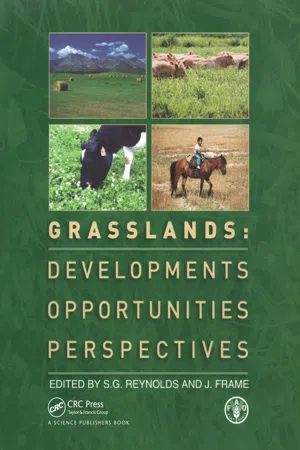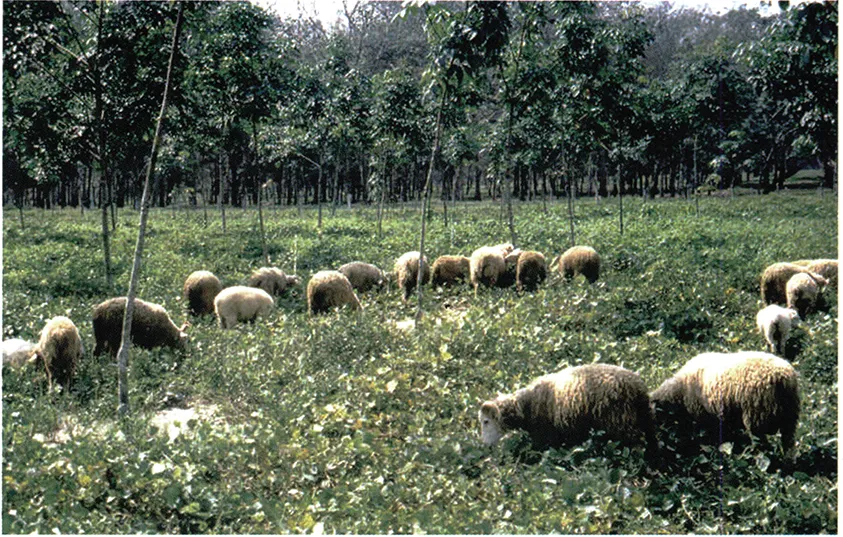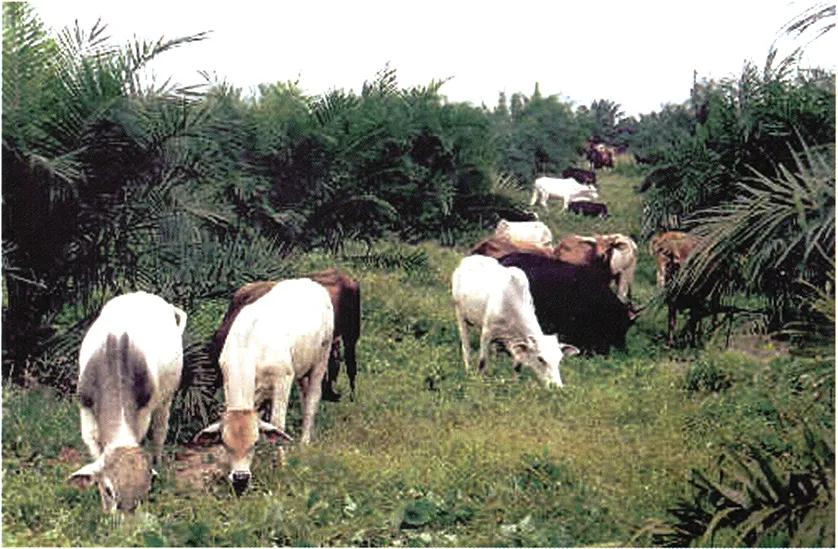
eBook - ePub
Grasslands
Developments, Opportunities, Perspectives
Stephen Reynolds
This is a test
- 556 Seiten
- English
- ePUB (handyfreundlich)
- Über iOS und Android verfügbar
eBook - ePub
Grasslands
Developments, Opportunities, Perspectives
Stephen Reynolds
Angaben zum Buch
Buchvorschau
Inhaltsverzeichnis
Quellenangaben
Über dieses Buch
This book looks at significant current grassland problems and issues, and provides an insight into grassland productivity in diverse areas of the world, with their various production systems. There is a focus on recent technical advances and the prospects for further innovation, through twenty-one chapters by eminent grassland scientists, grouped i
Häufig gestellte Fragen
Wie kann ich mein Abo kündigen?
Gehe einfach zum Kontobereich in den Einstellungen und klicke auf „Abo kündigen“ – ganz einfach. Nachdem du gekündigt hast, bleibt deine Mitgliedschaft für den verbleibenden Abozeitraum, den du bereits bezahlt hast, aktiv. Mehr Informationen hier.
(Wie) Kann ich Bücher herunterladen?
Derzeit stehen all unsere auf Mobilgeräte reagierenden ePub-Bücher zum Download über die App zur Verfügung. Die meisten unserer PDFs stehen ebenfalls zum Download bereit; wir arbeiten daran, auch die übrigen PDFs zum Download anzubieten, bei denen dies aktuell noch nicht möglich ist. Weitere Informationen hier.
Welcher Unterschied besteht bei den Preisen zwischen den Aboplänen?
Mit beiden Aboplänen erhältst du vollen Zugang zur Bibliothek und allen Funktionen von Perlego. Die einzigen Unterschiede bestehen im Preis und dem Abozeitraum: Mit dem Jahresabo sparst du auf 12 Monate gerechnet im Vergleich zum Monatsabo rund 30 %.
Was ist Perlego?
Wir sind ein Online-Abodienst für Lehrbücher, bei dem du für weniger als den Preis eines einzelnen Buches pro Monat Zugang zu einer ganzen Online-Bibliothek erhältst. Mit über 1 Million Büchern zu über 1.000 verschiedenen Themen haben wir bestimmt alles, was du brauchst! Weitere Informationen hier.
Unterstützt Perlego Text-zu-Sprache?
Achte auf das Symbol zum Vorlesen in deinem nächsten Buch, um zu sehen, ob du es dir auch anhören kannst. Bei diesem Tool wird dir Text laut vorgelesen, wobei der Text beim Vorlesen auch grafisch hervorgehoben wird. Du kannst das Vorlesen jederzeit anhalten, beschleunigen und verlangsamen. Weitere Informationen hier.
Ist Grasslands als Online-PDF/ePub verfügbar?
Ja, du hast Zugang zu Grasslands von Stephen Reynolds im PDF- und/oder ePub-Format sowie zu anderen beliebten Büchern aus Biological Sciences & Botany. Aus unserem Katalog stehen dir über 1 Million Bücher zur Verfügung.
Information
Section VII
REGIONAL DEVELOPMENTS
CHAPTER 17
Forage and Ruminant Livestock Integration in Tree Crop Plantations of Southeast Asia
C.C. Wong1, F. Moog2 and C.P. Chen3
ABSTRACT
The current scenario for the development of forage, livestock and tree crop integration in Southeast Asia is presented and discussed in relation to its potential for future development of a sustainable ruminant industry in ASEAN countries. Using the Malaysian model, the R&D on cattle-oil palm integration from its early conception in the seventies to commercialisation of its technology in the late nineties, was highlighted. Various aspects are reviewed, including forage feed availability and its changes with tree-crop maturity, and potential use of crop by-products by ruminants. Scientific findings have helped to dispel negative attitudes of planters towards ruminant rearing in plantations, and also provide a firm basis for a holistic approach in livestock-tree crop integration. Although nutrient availability per tonne of DM forage declines with age of the plantation crop, the major nutritional drawback is its forage yield reduction per unit land area. The use of agricultural by-products from the plantations to compensate for diminishing supply of forages in mature stands is discussed. The cattle component is now regarded as complementary to plantation crop production, and collaboration among research institutions, government agencies and plantation entrepreneurs has made cattle-tree-crops integration a successful and economically viable investment. Future research and development priorities will depend on reorientation to a multidisciplinary and multisectoral systems approach that addresses efficient resource use and management for environmentally sustainable development of the ruminant industry within plantation systems.
Introduction
The new millennium will witness the inevitable increasing urbanization of Southeast Asia, a steadily rising standard of living as a consequence of economic development, and a rapid increase in population. Despite the recent economic downturn of the Southeast Asian countries, the projected trends in per capita consumption of livestock products are for significant increases in the next years. In the past, total meat consumption per capita increased from 9.4 kg in 1961 to 21.0 kg year-1 in 1995, with pigs and poultry being the major meat sources (FAO, 1999). This increase in demand for livestock products has exacerbated competition for agricultural land and labour between animal and crop production. As livestock density increases, particularly in areas of intensive cropping systems, it is only a matter of time until issues of land availability constrain future livestock production, and environmental sustainability will need to be addressed rationally.
Traditionally, cropping agriculture in Southeast Asia is already intensive. Plantation agriculture is the only sector that has the potential for maximizing land use and promoting agricultural diversity and sustainability using environmental friendly cultural practices. It is for these reasons that integration of livestock within the agriculture cropping industry in Southeast Asia has received renewed emphasis in the new millennium (Table 17.1)
Table 17.1 Availability of forages for ruminants from potential grazing areas of Southeast Asia.
Land use type | Area (million ha) | Yield (1) (t DM ha"1 yr1) | Availability (million t DM yr !) |
Permanent pasture | 17.1 | 0.8 | 13.68 |
Forest and woodland | 229.6 | 0.2 | 45.93 |
Permanent crops | 28.5 | 0.4 | 11.40 |
Other land use | 98.6 | 0.4 | 39.43 |
Total | 373.8 | 110.44 |
Notes: (1) Average yields proposed by Roxas, Wanapat and Winugroho, 1997. Source: Adapted from Pezo et ah, 1999.
Over 210 million hectares of agricultural land are estimated to be under perennial tree crops in Southeast Asia (Alexandratos, 1995). The countries in Southeast Asia with huge plantation crops are Indonesia, Malaysia and Philippines, and these three countries account for over 80 percent of the plantation land. Currently oil-palm occupies over 5.2 million hectares of land, coconut 6.6 million hectares and rubber 5.7 million hectares. The potential for integrating such perennial tree crops with large and small ruminants is great. Rubber, oil-palm and coconut plantations in Indonesia, Viet Nam and Malaysia, teak forests in Lao PDR and Myanmar, and coconut and tropical orchards in the Philippines and Thailand have not been fully exploited for ruminant integration purposes. In Malaysia, the preferred options under rubber are small ruminants (Plate 17.1), with large ruminant under oil-palm (Plate 17.2). In coconut plantations, both large (Plate 17.3) and small ruminants are used.
It is not surprising that a number of livestock integration projects with plantation crops, especially coconut, were initiated as early as the 1970s to stabilize, if not increase, the income of smallholders from the dual use of land. One result has been voluminous publications on research and development (R&D) of integration projects, which were extensively reviewed by Reynolds (1995). The 3.16 million hectares of coconuts in the Philippines offer tremendous potential for integration of ruminants and diversification of income (Moog and Faylon, 1991; Deocareza and Diesta, 1993; Castillo, 1995). The present low copra and coconut oil prices and an uncertain future for coconut plantations with declining production due to palm senescence are good reasons for considering livestock integration. Although higher yielding coconut hybrids are being introduced, the adoption of new technologies has been slow for various socio-economic reasons.

Plate 17.1 Sheep grazing under young rubber in Malaysia.
[Photograph by Ismail Tajuddin]

Plate 17.2 Beef cattle-oil palm integration on a FELDA [Federal Land Development Authority] plantation in Serting, Negri Sembilan, Malaysia.
[Photograph by Dr Stephen Reynolds]

Plate 17.3 Cattle grazing native pastures under old coconuts.
[Photograph by Dr Stephen Reynolds]
In Indonesia, the cattle component was estimated to contribute as much as 75 percent of the total farm income in coconut-cattle enterprises (Iniguez and Sanchez, 1991). In Malaysia, the high import food bill, estimated at over US$ 3 billion per year, has prompted the government to promote a national policy of integration of livestock in plantations as an urgent measure to reduce the food bill in the face of national economic slowdown. At present, livestock-tree cropping integration is still being looked upon as an avenue for the expansion of food crops and the ruminant industry in countries of Southeast Asia with limited land resources.
Current Status of Animal Production Systems in Plantations
The concept of integrating livestock under plantation crops such as coconut, rubber and oil-palm is not new (Dalzell, 1983; Ani Arope, 1988; Khusahry et al.r 1988; Tajuddin, 1988; Hassan and Sani, 1991; Reynolds, 1995; 1998). Many farmers in countries of Southeast Asia have already implemented such a system, using locally available forages and cattle rearing in plantations to supplement their income and meat supply. The animal species are mainly carabao, beef or dairy cattle, goats, or, more recently, sheep. In addition, various crop by-products (weeds, tree leaves and wayside forages) have been incorporated as animal feed (Devendrá, 1979). Generally, the livestock reared are on a low to medium plane of nutrition. The animals are tethered or allowed to graze freely all year round.
In many Southeast Asian countries, ruminant raising is predominately a supplementary enterprise. Livestock are raised for agricultural as well as social reasons, and often not for business investment. Selling of animal takes place only when the need arises, although the pattern is changing slightly in Malaysia, the Philippines and Thailand, where livestock rearing is becoming a business enterprise.
While much R&D in the 1970s concentrated on selection of improved species for integration purposes, the adoption of improved management practices for such technology is insignificant (Chen et al., 1991). Cattle breeding and fattening operations are feasible in coconut plantations, and these can be based on grazing of improved or native pastures, or cut-and-carry feeding systems, depending on the size of the operation. Grazing systems are generally used in more extensive coconut production areas, such as in North Sulawesi, Indonesia, parts of the Philippines and in many South Pacific countries. In Mindanao, the second largest island of the Philippines, approximately 20 percent of the cattle-coconut farms have improved pastures, such as signal grass (Brachiaria decumbens) and centro (Centrosema pubescens). However, proper management must include proper fertilization and stocking rate control to ensure the sustainability of such undertakings (Castillo, 1995).
On most farms, cattle have been grazed on natural vegetation and in general the investment in forages was less than 1 percent (Arganosa, 1988). In the Philippines, there have been deliberate efforts to develop integrated livestock-tree crop projects. For example, the International Development Research Centre (IDRC) and others have supported tree crops+small ruminants systems, where sociologists, livestock scientists and forage agronomists worked together. Such a structural set-up and system approach has not been effective in promoting the development of the industry.
A new approach is required to increase the awareness of farmers concerning the benefits of using improved practices in integrated livestock-coconut production. A participatory approach involving introduction of R&D with farmers to speed up technology adoption was promoted in Southeast Asia. The success of this approach remains to be seen.
In Malaysia, extension programmes are mainly government-driven through subsidies and incentives. Many of the R&D programmes initiated in the 1970s and 1980s involved government, international aid and development agencies such as the Australian Centre for International Agricultural Research (ACIAR), FAO and others. Verification or demonstration projects were carried out on smallholdings, government-backed land schemes and private estates to evaluate the commercial viability of sheep and cattle under rubber and oil-palm. The adoption of such technology among the farmers has been limited. It was only comparatively recently that cattle production in the rubber (see Plate 17.4) and oil-palm sectors has been identified as a major thrust towards increasing beef production. Consequently, tree crop-livestock integration in the plantation estate sector is taking on a new dimension. There has been an increase in the number of cattle through integration activities by small-scale farmers. However, involvement in livestock production by the estates that occupy about 50 percent and 18 percent of the oil-palm and rubber plantation land, respectively, is still low.
Nevertheless, the positive results generated from R&D in the Malaysian plantation-based livestock integration in the 1980s and 1990s have led to the development of the current national agricultural policy, whereby this sector is expected to contribute significantly towards the overall improvement in red meat production in Malaysia alone. A target of 240 000 tonne has been set, to be achieved by 2010, implying an annual growth rate of 6.9 percent, compared with the average annual growth rate of 0.3 percent in 1985-1995.
The future direction and the expected role of government in encouraging greater involvement of estates in integration activities could be intensified considerably. However, farmers will be constrained by resource endowment, supporting infrastructure, market potential and policies favouring intensification, diversification and specialization (Devendrá et al., 1997).
In Thailand, livestock+crop-based production systems are very much concentrated in the southern part of the country, where agriculture is dominated by rubber, oil-palm and tropical orchards. Coconut plantations cover 44 000 ha and para rubber plantations 1 650 000 ha, which could be used for forage integration. The integration of cattle with plantation systems is less practised than cattle in file rice systems* However, some farmers rear cattle and goats as weeders for their plantations. A few have sown improved forages for their animals. Koronivia grass (Bmchiaria humidicola), guineagrass (Panicum maximum), ruzi grass (Brachiaria ruziziensi...
Inhaltsverzeichnis
- Cover
- Title Page
- Copyright Page
- Foreword
- Preface
- Acknowledgements
- Table of Contents
- List of Contributors
- Section I - Forage Germplasm
- Section II - Forage Conservation
- Section III - Grass-Based Systems and Organic Production
- Section IV - Climate Change, Biodiversity and Biotechnology
- Section V - Geographical Information Systems (GIS)
- Section VI - Farmer and Pastoralist Participation
- Section VII - Regional Developments
Zitierstile für Grasslands
APA 6 Citation
[author missing]. (2019). Grasslands (1st ed.). CRC Press. Retrieved from https://www.perlego.com/book/1475265/grasslands-developments-opportunities-perspectives-pdf (Original work published 2019)
Chicago Citation
[author missing]. (2019) 2019. Grasslands. 1st ed. CRC Press. https://www.perlego.com/book/1475265/grasslands-developments-opportunities-perspectives-pdf.
Harvard Citation
[author missing] (2019) Grasslands. 1st edn. CRC Press. Available at: https://www.perlego.com/book/1475265/grasslands-developments-opportunities-perspectives-pdf (Accessed: 14 October 2022).
MLA 7 Citation
[author missing]. Grasslands. 1st ed. CRC Press, 2019. Web. 14 Oct. 2022.